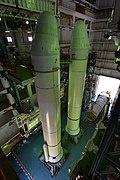This is a GLSV MK-III D1. It is the first rocket replica made by me. It is made with mods MOBILE VERSION IS HERE. All Activation Groups are marked but the Sliders aren't, So the Sliders are as follows ::
AG 3 + Slider 2 : Secondary Dish.
AG 9 + Slider 1: Solar Panels Rotation.
MORE ABOUT THE VEHICLE
The Geosynchronous Satellite Launch Vehicle Mark III (GSLV Mk III), also referred to as the Launch Vehicle Mark 3 (LVM3), is a three-stage medium-lift launch vehicle developed by the Indian Space Research Organisation (ISRO). Primarily designed to launch communication satellites into geostationary orbit, it is also identified as launch vehicle for crewed missions under the Indian Human Spaceflight Programme and dedicated science missions like Chandrayaan-2. The GSLV Mk III has a higher payload capacity than the similarly named GSLV Mk II.

SOLID ROCKET BOOSTERS
The first stage consists of two S200 solid motors, also known as Large Solid Boosters (LSB) attached to the core stage. Each booster is 3.2 metres (10 ft) wide, 25 metres (82 ft) long, and carries 207 tonnes (456,000 lb) of propellant. The S200 booster uses an HTPB based propellant. It is the largest solid-fuel booster after the Space Shuttle SRBs and Ariane 5 SRBs

CORE STAGE
The second stage, designated L110, is a liquid-fueled stage that is 21 metres (69 ft) tall and 4 metres (13 ft) wide, and contains 110 metric tons (240,000 lb) of unsymmetrical dimethylhydrazine (UDMH) and nitrogen tetroxide (N
2O
4). It is powered by two Vikas 2 engines, each generating 766 kilonewtons (172,000 lbf) thrust, giving a total thrust of 1,532 kilonewtons (344,000 lbf).The L110 is the first Indian clustered liquid-fueled engine. The Vikas engines uses regenerative cooling, providing improved weight and specific impulse compared to earlier Indian rockets.

SECOND STAGE
The cryogenic upper stage, designated C25, is 4 metres (13 ft) in diameter and 13.5 metres (44 ft) long, and contains 28 metric tons (62,000 lb) of propellant LOX and LH2.[38] It is powered by the CE-20 engine, producing 200 kN (45,000 lbf) of thrust. CE-20 is the first cryogenic engine developed by India which uses a gas generator, as compared to the staged combustion engines used in GSLV.


PAYLOAD
GSAT-19 is an Indian communications satellite launched by the Indian Space Research Organisation aboard a GSLV Mark III on 5 June 2017.GSAT-19 satellite with a lift-off mass of 3136 kg, is the communication satellite of India, configured around the ISRO’s standard I-3K bus.
GSAT-19 carries Ka/Ku-band high throughput communication transponders. Besides, it carries a Geostationary Radiation Spectrometer (GRASP) payload to monitor and study the nature of charged particles and the influence of space radiation on satellites and their electronic components. GSAT-19 also features certain advanced spacecraft technologies including miniaturised heat pipe, fibre optic gyro, Micro Electro-Mechanical Systems (MEMS) accelerometer, Ku-band TTC transponder, as well an indigenous Lithium-ion Battery.

I RECOMMEND USING KAL BEACAUSE IT SPINS
GENERAL INFO
- Created On: Windows
- Game Version: 0.9.403.0
- Price: $41,562k
- Number of Parts: 431
- Dimensions: 47 m x 13 m x 7 m
PERFORMANCE
- Total Delta V: 38.8km/s
- Total Thrust: 18.0MN
- Engines: 13
- Wet Mass: 6.46E+5kg
- Dry Mass: -97,505kg
STAGES
| Stage | Engines | Delta V | Thrust | Burn | Mass |
|---|---|---|---|---|---|
| 1 | 6 | 35.6km/s | 15.7MN | 2.3m | 6.46E+5kg |
| 2 | 0 | 0m/s | 0N | 0s | 3.8E+5kg |
| 4 | 1 | 2.0km/s | 712kN | 2.8m | 79,745kg |
| 7 | 4 | 1.2km/s | 43kN | 2.2m | 5,343kg |
REQUIRED MODS
-
Stock Engine Overhaul
by Complex Rockets
Version 1.4 (3/20/2020 6:00:39 AM)
View Mod Page -
Simple Decals
by Complex Rockets Team Aram Pedro16797
Version 4.1 (3/15/2020 10:22:55 AM)
5 Comments
- Log in to leave a comment
-
-
-
-
8,474 General98Ishaan5.3 years ago
Love this rocket!!!!!!!!!!!! I just love replicas of India's rocket!! And its GSLV MK III. And can you please tell me that how you write letters on rockets?







The Mobile Version Is HERE